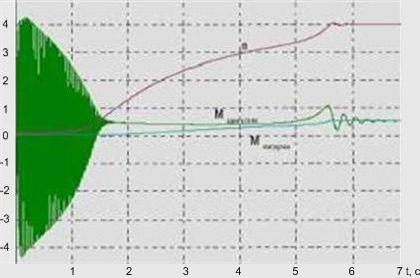















|
SYSTEMS FOR SOFT-START OF MEDIUM VOLTAGE ELECTRIC MOTORS
PROBLEMS ASSOCIATED WITH DIRECT START OF ELECTRIC MOTORS AND SOLUTIONS THEREOF
Direct-on-line start of a medium-voltage electric motor involves an inrush current of 6-8 times the rated value. It results in a torque burst transmitted to the mechanism driven via the motor shaft. During 1.5-2 seconds this torque consists of a direct component and an alternating component. The latter is up to 4 times as large as the rated torque of the motor. The alternating torque causes vibration of the motor and the mechanism. Electromagnetic forces arising in the stator windings cause displacement of wires relative to each other. These impact loads bring about destruction and breakdown of the stator winding insulation, burning-out of leads and interconnections between the coils, failure of gears, shafts and joint ends, etc. As a result, smooth production flow is disrupted and the throughput rate is reduced. Enterprises bear considerable expenses for repairing broken-down equipment.

Fig. 1 Oscillograms for a 5000 kW/6 kV squirrel-cage motor
Fig. 1 shows direct start oscillograms for a 5000 kW/6 kV squirrel-cage motor driving a pump. One can see that the start-up time is 5.7 s at a current of 6 Irat while the alternating component of the motor torque in the beginning of the transient amounts to 4.0-4.1 Trat.
If acceleration time exceeds 8-10 s, the motor start-up conditions become extremely harsh. In addition to large electrodynamic forces the motor windings are subjected to intensive heating by high start-up currents. In this case generated heat has no time to dissipate in the stator or rotor cores, causing overheating of the motor windings that results in deterioration of insulation and breakdowns. This can be exemplified in a breakage of 8000 kW/6 kV motor driving a turbocompressor, whose start-up time was 12-14 s. After 45 start-ups the insulation of the motor was practically destroyed by impact dynamic loads and overheating. A phase-to-phase short circuit occurred in the slot part of the winding, followed by ground fault in the outhang and inflammation of the motor.
Inrush currents have negative impact on the feeding network as well. They cause big voltage sags that affect operation of other equipment. Normal flow of technological processes is disturbed and enterprises suffer losses from underproduction.
High currents consumed by electric motors during start-up and the voltage sags involved complicate and sometimes make impossible powering motors from gas-turbine, diesel or other power facilities with limited capacity. As a result, personnel running medium-voltage motors strives for providing their uninterrupted operation for as long as possible, even though this is not required by technology. Correspondingly, considerable amount of power is wasted.
Due to high impact torque the guaranteed lifetime of equipment is shortened. As reported by development and production company "Regioturbocom Ltd.", each start of the K-250 or K-500 centrifugal compressor with 1600 and 3150 kW motors reduces the unit lifetime by 50 hours (and up to 200 hours with larger compressor installations). Therefore manufacturers of MV-motors and mechanisms employing those limit the permitted number of start-ups to 50-60 per year. Consequently, compressor units with MV-motors are rarely stopped (in spite of such possibility from technological viewpoint), that causes unjustified power losses. Stopping a K-250 compressor for 8 hours at night and at holidays translates into annual energy saving of more than 3.5 million kW-h (depending on regional electricity charges - at least 100,000 USD a year).
The problem of eliminating start-up impact loads and voltage sags, and consequently raising the reliability of installations with MV-motors can be solved by using the UBPVD soft-start devices developed in our institute.
Depending on the load characteristics of a mechanism driven, two versions of the device can be offered:
UBPVD-V, intended for mechanisms with a "fan-type" load characteristics (centrifugal pumps, compressors, ventilators);
UBPVD-S, providing soft start of synchronous motors in mechanisms with high static torque and inertia (mills, exhausters etc.).
For soft start of MV-motors in "fan-type" installations both the versions (depending on the problem to be solved) can be used.
Impact loads as such can be excluded by using the UBPVD-V device. In this case the start-up current at the end of acceleration is about 2.5 Irat. If in addition to removal of impact loads limitation of the inrush current (at a level of 1-1.5 Irat) is required, we recommend to use the more sophisticated and expensive device, UBPVD-S.
Первоисточник: http://www.absholdings.biz/engleski/home.html








|
| ДонНТУ Портал магистров Автореферат Библиотека Ссылки Отчет о поиске Индивидуальное задание Начало |